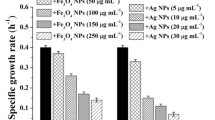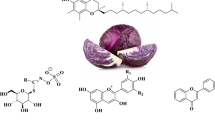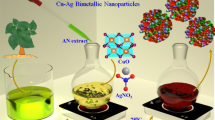Abstract
The toxic action of CuO–Ag Janus particles and a bicomponent mixture of CuO and Ag particles have been studied against a recombinant strain Escherichia coli K12 TG1 with cloned luxCDABE genes of marine bacteria Photobacterium leiognathi 54D10. An original method was used for the preparation CuO–Ag Janus like nanoparticles by simultaneous electrical explosion of twisted Cu and Ag wires in a mixture of argon and oxygen gases. The bioluminescence inhibition on recombinant strain E. coli shows that CuO–Ag Janus NPs were effective. The concentration by 50% (EC50) for CuO–Ag Janus NPs was 0.03 ± 0.001 mg/ml (p < 0.05). The bioactivity of the bicomponent mixture of CuO and Ag NPs (EC50) was 0.25 ± 0.002 mg/ml (p < 0.05). The effective concentration of CuO–Ag Janus NPs against E. coli was comparatively lower than those of bicomponent mixture CuO and Ag against which explains the higher activity of CuO–Ag Janus NPs. The toxicity values of CuO and Ag as monocomponent nanoparticles were 2–32 times lower compared with the bicomponent nanoparticles. A dose-dependent inhibition of bacterial luminescence developed over time was noted. The result of contact E. coli with CuO–Ag Janus particles was 100% suppression of bacterial luminescence from the first minutes of contact occured starting with a content of 2.0 mg/ml and within the next 180 min. The effect of bioactivity prolonged in the final concentration of nanopowder (EC100 = 0.0625 ± 0.002 mg/ml) (p < 0.05). CuO–Ag Janus particles exhibited more pronounced antibacterial activity compared to CuO, Ag nanoparticles and their mechanical mixture.







Similar content being viewed by others
Data availability
The authors confirm that the data supporting the findings of this study are available within the article and its supplementary materials.
References
Abozeid Y, Williams G (2019) The potential anti-infective applications of metaloxide nanoparticles: a systematic review. Wiley Interdiscip Rev Nanomed Nanobiotechnol 12(3):1–36. https://doi.org/10.1002/wnan.1592
Alavi M, Rai M (2019) Recent advances in antibacterial applications of metal nanoparticles (MNPs) and metal nanocomposites (MNCs) against multidrug resistant (MDR) bacteria. Expert Rev Anti Infect Ther 17(6):419–428. https://doi.org/10.1080/14787210.2019.1614914
Applerot G, Lellouche J, Lipovsky A, Nitzan Y, Lubart R, Gedanken A, Banin E (2012) Understanding the antibacterial mechanism of CuO nanoparticles: revealing the route of induced oxidative stress. Small 8(21):33–37. https://doi.org/10.1002/smll.201200772
Asamoah RB, Annan E, Mensah B, Nbelayim P, Apalangya VB, Onwona-Agyeman B, Yaya A (2020) A comparative study of antibacterial activity of CuO/Ag and ZnO/Ag nanocomposites. Adv Mater Sci Eng 2020:18. https://doi.org/10.1155/2020/7814324
Bondarenko OM, Sihtmäe M, Kuzmičiova J, Ragelienė L, Kahru A, Daugelavičius R (2018) Plasma membrane is the target of rapid antibacterial action of silver nanoparticles in Escherichia coli and Pseudomonas aeruginosa. Int J Nanomed 26(13):6779–6790. https://doi.org/10.2147/IJN.S177163
Bonilla-Gameros L, Chevallier P, Sarkissian A, Mantovani D (2020) Silver-based antibacterial strategies for healthcare-associated infections: processes, challenges, and regulations. Integr Rev Nanomed 24:102–142. https://doi.org/10.1016/j.nano.2019.102142
Cotton G, Lagesse N, Parke L, Meledandri C (2019) Antibacterial nanoparticles. In: Comprehensive nanoscience and nanotechnology; 2nd ed. 3: 65–82. https://doi.org/10.1016/B978-0-12-803581-8.10409-6
Ferdous Z, Nemmar A (2020) Health impact of silver nanoparticles: a review of the biodistribution and toxicity following various routes of exposure. Int J Mol Sci 21(7):2375. https://doi.org/10.3390/ijms21072375
Gabrielyan L, Trchounian A (2019) Antibacterial activities of transient metals nanoparticles and membranous mechanisms of action. World J Microbiol Biotechnol 35(162):1–10. https://doi.org/10.1007/s11274-019-2742-6
Ghasemi N, Jamali-Sheini F, Zekavati R (2017) CuO and Ag/CuO nanoparticles: biosynthesis and antibacterial properties. Mater Lett 196:78–82. https://doi.org/10.1016/j.matlet.2017.02.111
Hasanin M, Elbahnasawy MA, Shehabeldine AM et al (2021) Ecofriendly preparation of silver nanoparticles-based nanocomposite stabilized by polysaccharides with antibacterial, antifungal and antiviral activities. Biometals 34:1313–1328. https://doi.org/10.1007/s10534-021-00344-7
Hasanin M, Abboud MA, Alawlaqi MM et al (2022) Ecofriendly synthesis of biosynthesized copper nanoparticles with starch-based nanocomposite: antimicrobial, antioxidant, and anticancer activities. Biol Trace Elem Res 200:2099–2112. https://doi.org/10.1007/s12011-021-02812-0
Hashem AH, Saied E, Amin BH, Alotibi FO, Al-Askar AA et al (2022) Antifungal activity of biosynthesized silver nanoparticles (AgNPs) against Aspergilli causing Aspergillosis: ultrastructure study. J Funct Biomater 13:242. https://doi.org/10.3390/jfb13040242
Helmlinger J, Sengstock C, Grob-Heitfeld C, Mayer C, Schildhauer TA, Koler M, Epple M (2016) Silver nanoparticles with different size and shape: equal cytotoxicity, but different antibacterial effects. RSC Adv 6:18490–18501. https://doi.org/10.1039/c5ra27836h
Ivask A, Juganson K, Bondarenko O, Mortimer M, Aruoja V, Kasemets K, Blinova I, Heinlaan M, Slaveykova V, Kahru A (2014) Mechanisms of toxic action of Ag, ZnO and CuO nanoparticles to selected ecotoxicological test organisms and mammalian cells in vitro: a comparative review. Nanotoxicology 1:57–71. https://doi.org/10.3109/17435390.2013.855831
Javadhesari SM, AlipourS MS, Akbarpour MR (2019) Antibacterial activity of ultra-small copper oxide (II) nanoparticles synthesized by mechanochemical processing against S. aureus and E. coli. Mater Sci Eng C Mater Biol Appl 105:110011. https://doi.org/10.1016/j.msec.2019.110011
Joshi MK, Pant HR, Kim HJ, Kim JH, Kim CS (2014) One-pot synthesis of Ag-iron oxide/reduced graphene oxide nanocomposite via hydrothermal treatment. Colloids Surf A 446:102–108
Kotov YuA (2003) Electric explosion of wires as a method for preparation of nanopowders. J Nanopart Res 5:539–550. https://doi.org/10.1023/B:NANO.0000006069.45073.0b
Laskowska M, Kowalczyk P, Karczmarska A, Kramkowski K, Wrzosek K, Laskowski Ł (2023) A novel biocidal nanocomposite: spherical silica with silver ions anchored at the surface. Int J Mol Sci 24(1):545. https://doi.org/10.3390/ijms24010545
Lehtinen J, Virta M, Lilius EM (2003) Fluoro-luminometric real-time measurement of bacterial viability and killing. J Microbiol Methods 55(1):173–186. https://doi.org/10.1016/S0167-7012(03)00134-9
Leontev V, Kuznetsov D, Frolov G, Pogorelskiy I, Latuta N, Ya K (2017) Antibacterial effects of nanoparticles of metals. Russ J Immunol 21(6):304–307
Lerner MI, Glazkova EA, Lozhkomoev AS (2016) Synthesis of Al nanoparticles and Al/AlN composite nanoparticles byelectrical explosion of aluminum wires in argon and nitrogen. Powder Technol 295:307–314. https://doi.org/10.1016/j.powtec.2016.04.005
Liao C, Li Y, Tjong S (2019) Bactericidal and cytotoxic properties of silver nanoparticles. Int J Mol Sci 20(2):449. https://doi.org/10.3390/ijms20020449
Lv Y, Li L, Yin P, Lei T (2020) Synthesis and evaluation of the structural and antibacterial properties of doped copper oxide. Dalton Trans 15(49):4699–4709. https://doi.org/10.1039/D0DT00201A
Ma C, Yang Z, Wang W, Hao X, Zhang M, Zhu S, Chen S (2020) Fabrication of Ag-Cu ed nanocomposite coatings with silver nanoparticles. RSC Adv 10:10155–10166. https://doi.org/10.1039/c9ra10874b
Meleshko AA, Afinogenova AG, Afinogenov GE, Spiridonova AA, Tolstoy VP (2020) Antibacterial inorganic agents: efficiency of using multicomponent systems. Infect Immun 10(4):639–654. https://doi.org/10.15789/2220-7619-AIA-1512
Nizami MZI, Xu VW, Yin IX, Yu OY, Chu C-H (2021) Metal and metal oxide nanoparticles in caries prevention: a review. Nanomaterials 11(12):3446. https://doi.org/10.3390/nano11123446
Oladapo EO, Stainsby F, Abdulsalami MS, Oaikhena EE (2017) Development of high-throughput methods for nano- and bulk silver toxicity assays using bioluminescent recombinant pseudomonas wastewater isolates. Front Environ Microbiol 3(2):30–38. https://doi.org/10.11648/j.fem.20170302.12
Pal S, Kyung Tak Y, Myong Song J (2007) Does the antibacterial activity of silver nanoparticles depend on the shape of the nanoparticle? A study of the gram-negative bacterium Escherichia coli. Appl Environ Microbiol 73(6):1712–1720. https://doi.org/10.1128/AEM.02218-06
Pasparakis G (2022) Recent developments in the use of gold and silver nanoparticles in biomedicine. Wires Nanomed Nanobiotechnol 14(5):1817. https://doi.org/10.1002/wnan.1817
Pervikov AV, Kazantsev SO, Lozhkomoev AS, Lerner MI (2020) Bimetallic Al/Ag, Al/Cu and Al/Zn nanoparticles with controllable phase compositions prepared by the electrical explosion of two wires. Powder Technol 372:136–147. https://doi.org/10.1016/j.powtec.2020.05.088
Pi S, Luo Y, Liu YJ (2022) Thorough understanding of bioluminophore production in bacterial bioluminescence. J Phys Chem 126(38):6604–6616. https://doi.org/10.1021/acs.jpca.2c04311
Qin Z, Zheng Y, Wang Y, Du T, Li C, Wang X, Jiang H (2021) Versatile roles of silver in Ag-based nanoalloys for antibacterial applications. Coord Chem Rev 449:214218. https://doi.org/10.1016/j.ccr.2021.214218
Rajabi A, Ghazali M, Mahmoudi E, Azizkhani S, Sulaiman N, Mohammad A, Mustafah N, Ohnmar H, Naicker A (2018) Development and antibacterial application of nanocomposites: effects of molar ratio on Ag2O-CuO nanocomposite synthesised via the microwave assisted route. Ceram Int 44(17):21591–21598. https://doi.org/10.1016/j.ceramint.2018.08.239
Ruparelia JP, Chatterjee AK, Duttagupta SP (2008) Strain specificity in antimicrobial activity of silver and copper nanoparticles. Acta Biomater 4(3):707–716
Safronyuk SL, Samolyuk VV, Milova AM, Havrichenko YY, Katsev AM (2020) Assessment of the applicability of primarily identified natural luminescent bacteria, isolated from the azov and the black seas, to determine the antimicrobial activity of antibiotics. Aspirantskiy Vestnik Povolzhiya 20(5–6):175–183. https://doi.org/10.17816/2072-2354.2020.20.3.175-183
Saied E, Hashem AH, Ali OM, Selim S, Almuhayawi MS, Elbahnasawy MA (2022) Photocatalytic and antimicrobial activities of biosynthesized silver nanoparticles using Cytobacillus firmus. Life 12:1331. https://doi.org/10.3390/life12091331
Salem SS, Hashem AH, Sallam AAM, Doghish AS, Al-Askar AA, Arishi AA, Shehabeldine AM (2022a) Synthesis of silver nanocomposite based on carboxymethyl cellulose: antibacterial antifungal and anticancer activities. Polymers 14:3352. https://doi.org/10.3390/polym14163352
Salem SS, Ali OM, Reyad AM, Abd-Elsalam KA, Hashem AH (2022b) Pseudomonas indica-mediated silver nanoparticles: antifungal and antioxidant biogenic tool for suppressing mucormycosis fungi. J Fungi 8:126. https://doi.org/10.3390/jof8020126
Shehabeldine AM, Salem SS, Ali OM, Abd-Elsalam KA, Elkady FM, Hashem AH (2022) Multifunctional silver nanoparticles based on chitosan: antibacterial, antibiofilm, antifungal, antioxidant, and wound-healing activities. J Fungi 8:612. https://doi.org/10.3390/jof8060612
Sorokina EV, Yudina TP, Bubnov IA, Danilov VS (2013) Evaluation of iron toxicity using a luminescent bacterial test on a recombinant strain of Escherichia coli. Mikrobiology 82(4):428–433. https://doi.org/10.1134/s0026261713040115
Toh HS, Batchelor-Mcauley C, Tschulik K, Compton RG (2014) Chemical interactions between silver nanoparticles and thiols: a comparison of mercaptohexanol against cysteine. Sci China Chem 57(9):1199–1210. https://doi.org/10.1007/s11426-014-5141-8
Acknowledgements
CuO-Ag nanoparticles have been prepared within the framework of the state task of ISPMS SB RAS, topic no FWRW-2022-0002.
Funding
No external funding received.
Author information
Authors and Affiliations
Contributions
Fomina M., Sizova E. wrote the main manuscript text. Nechitailo K. prepared figures 1-7. All authors reviewed the manuscript.
Corresponding author
Ethics declarations
Conflict of interest
The authors declare that they have no known competing financial interests or personal relationships that could have appeared to influence the work reported in this paper.
Additional information
Communicated by Yusuf Akhter.
Publisher's Note
Springer Nature remains neutral with regard to jurisdictional claims in published maps and institutional affiliations.
Rights and permissions
Springer Nature or its licensor (e.g. a society or other partner) holds exclusive rights to this article under a publishing agreement with the author(s) or other rightsholder(s); author self-archiving of the accepted manuscript version of this article is solely governed by the terms of such publishing agreement and applicable law.
About this article
Cite this article
Fomina, M., Sizova, E. & Nechitailo, К. Antibacterial activity of CuO-Ag Janus like nanoparticles against recombinant strain Escherichia coli. Arch Microbiol 205, 205 (2023). https://doi.org/10.1007/s00203-023-03546-4
Received:
Revised:
Accepted:
Published:
DOI: https://doi.org/10.1007/s00203-023-03546-4




